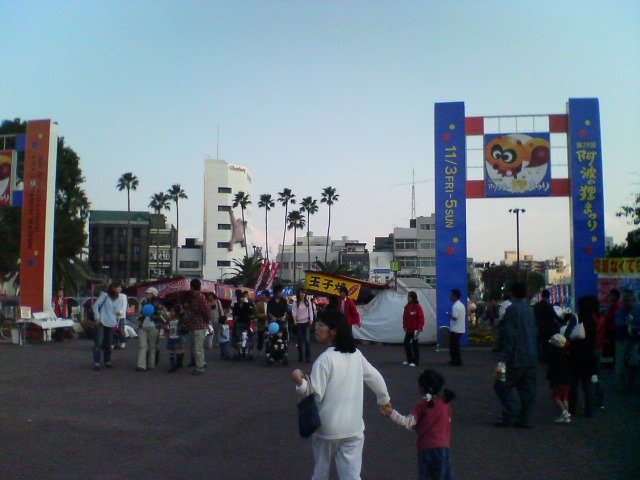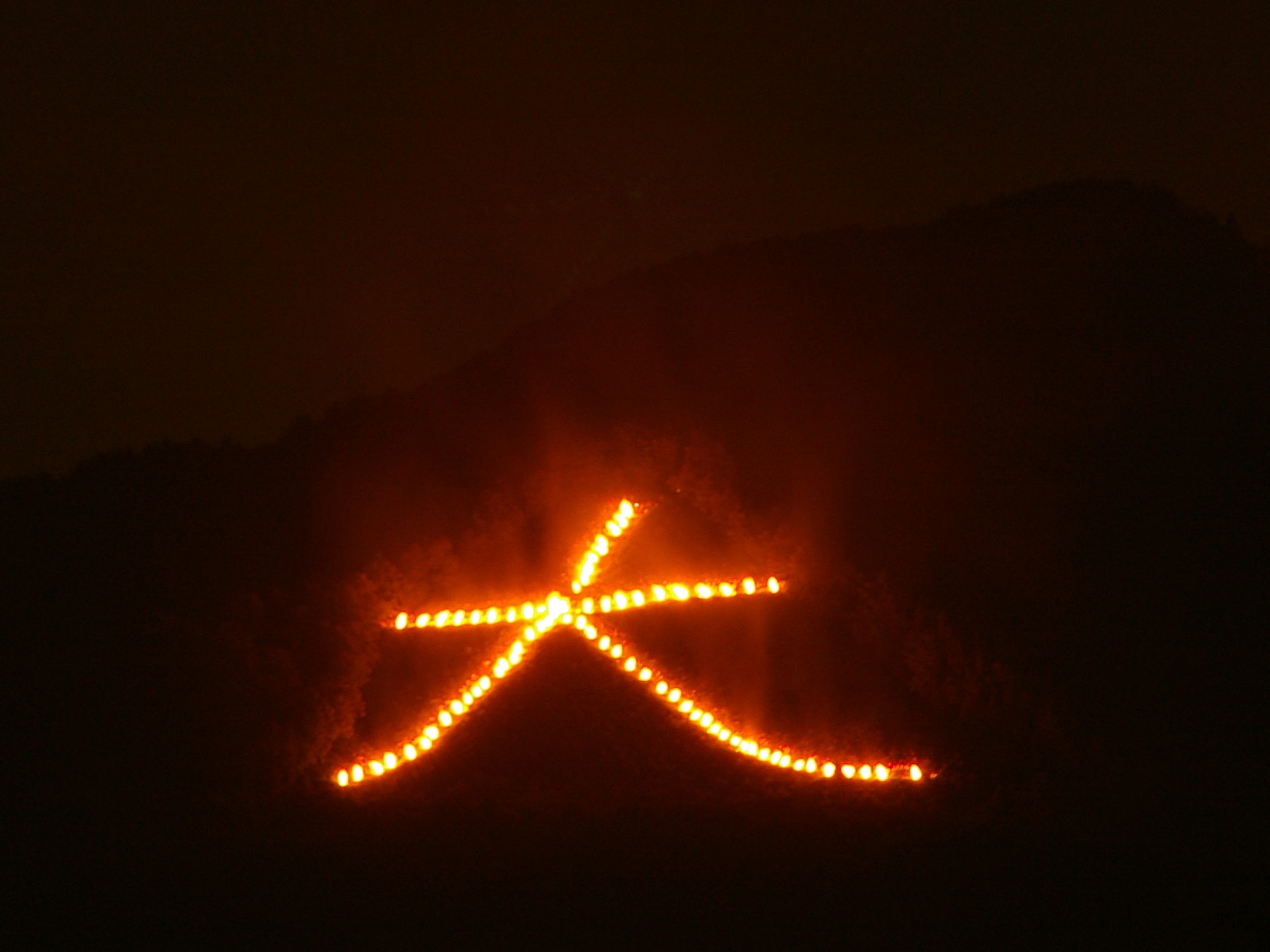|
Aibahama Park
Aibahama Park (藍場浜公園) is a park in Aiba-cho in Tokushima City in Tokushima Prefecture. Overview Found alongside the Shinmachi River that winds its way through the middle of Tokushima City, the Aibahama Park grounds are known as a popular place for events. In April there is the Hana Haru Festa, and the grounds are also used for one of the dancing stages in Awa Odori held during O-bon. Aibahama Park is also used during the local Awa no Tanuki Festival in November each year, and is the permanent home for the Tokushima Arts Foundation for Culture. * Local buildings / facilities - Tokushima Sogo、Tokushima CITY、 Poppo-gai、Tokushima Press Facilities on the grounds * The Tokushima Arts Foundation for Culture * The Shinmachi River Access * Five minutes walk from the JR Tokushima Station is a junction passenger railway station located in the city of Tokushima in Tokushima Prefecture, Japan, operated by the Shikoku Railway Company (JR Shikoku). Lines To ... [...More Info...] [...Related Items...] OR: [Wikipedia] [Google] [Baidu] |
Tokushima Arts Foundation For Culture
The Tokushima Arts Foundation for Culture (徳島県郷土文化会館) is a multi-purpose cultural facility found in the Aiba-cho district in Tokushima City, Tokushima Prefecture. It sits on the grounds of the Aibahama Park and runs alongside the Shinmachi River. Overview Location * 〒770-0835 Tokushima Prefecture, Tokushima City, Aiba-cho 2-14 (徳島県徳島市藍場町2丁目14番地) * TEL - 088-622-8121 * FAX - 088-622-8123 * Open Hours - 9:00~21:30 (Exhibitions until 17:00) * Open Period - January 4 to December 28 every year. Facilities * 1F - Multi-purpose hall (792 seats) * 2F - Special exhibition room * 3F - Exhibition room * 4F - Meeting rooms, etc. * 5F - Meeting rooms, etc. Access * Just eight minutes walk from the JR Tokushima Station is a junction passenger railway station located in the city of Tokushima in Tokushima Prefecture, Japan, operated by the Shikoku Railway Company (JR Shikoku). Lines Tokushima Station is the terminus of both the ... [...More Info...] [...Related Items...] OR: [Wikipedia] [Google] [Baidu] |
Tokushima Station
is a junction passenger railway station located in the city of Tokushima in Tokushima Prefecture, Japan, operated by the Shikoku Railway Company (JR Shikoku). Lines Tokushima Station is the terminus of both the Kōtoku Line (station number "T00") to and the Mugi Line (station number "M00") to . It is also served by direct trains to and from the Tokushima Line and Naruto Line. File:Tokushima Railway Station (platform).jpg, The platforms at Tokushima Station in August 2010 Layout The station consists of one island platform and one side platform with a notch to enable it to service two tracks. The station building is an 18-story structure with a multi-storey car park. The exit is only on the south side where the bus terminal is located, and facing the downtown area . The station has a ''Midori no Madoguchi'' staffed ticket office. History The station opened on 16 February 1899. With the privatization of Japanese National Railways (JNR), the successor of JGR, on 1 April 1987, ... [...More Info...] [...Related Items...] OR: [Wikipedia] [Google] [Baidu] |
Japan Railways Group
The Japan Railways Group, more commonly known as the or simply JR, consists of seven for-profit stock companies that took over most of the assets and operations of the government-owned Japanese National Railways (JNR) on April 1, 1987. Most of the liability of the JNR was assumed by the JNR Settlement Corporation. The JR Group lies at the heart of Japan's railway network, operating a large proportion of intercity rail service (including the Shinkansen high-speed rail lines) and commuter rail service. JR Hokkaido, JR Shikoku, and JR Freight (JRF) are governed by the , also known as the ''JR Companies Act'', and are under the control of the public Japan Railway Construction, Transport and Technology Agency (JRTT), while JR East, JR Central, JR West, and JR Kyushu have full private ownership. Because the railways used to be owned by the government, Japanese people generally make a distinction between JR railways (including former JR lines that are now third sector) and ot ... [...More Info...] [...Related Items...] OR: [Wikipedia] [Google] [Baidu] |
Tokushima Press
is a prefecture of Japan located on the island of Shikoku. Tokushima Prefecture has a population of 728,633 (1 October 2019) and has a geographic area of 4,146 km2 (1,601 sq mi). Tokushima Prefecture borders Kagawa Prefecture to the north, Ehime Prefecture to the west, and Kōchi Prefecture to the southwest. Tokushima is the capital and largest city of Tokushima Prefecture, with other major cities including Anan, Naruto, and Yoshinogawa. Tokushima Prefecture is located on the Kii Channel, connecting the Pacific Ocean and Seto Inland Sea, across from Wakayama Prefecture on the Kii Peninsula of the island of Honshu. Tokushima Prefecture is connected to Awaji Island across the Naruto Strait by the Ōnaruto Bridge as part of the Kobe-Awaji-Naruto Expressway, connecting the prefecture to the city of Kobe and the San'yō Expressway on Honshu. History Until the Meiji Restoration, Tokushima Prefecture was known as Awa Province. Tokushima Prefecture and Myodo Prefectur ... [...More Info...] [...Related Items...] OR: [Wikipedia] [Google] [Baidu] |
Tokushima CITY
is the capital city of Tokushima Prefecture on Shikoku island in Japan. , the city had an estimated population of 249,865 in 122085 households and a population density of 1305 persons per km².The total area of the city is . Geography The city is situated in the north-eastern part of Tokushima Prefecture at the mouth of the Yoshino River. In terms of layout and organization, Tokushima displays the typical characteristics of a Japanese castle town. Most of the city is located in the Tokushima plain and is flat, but the symbol of the city, Mt. Bizan, rises in the center, creating a scenic landscape. The southern part is a mountainous area with forests. Mountains Rivers * Akui River * Imagire River * Shinmachi River * Suketō River * Yoshino River Neighbouring municipalities Tokushima Prefecture * Komatsushima * Katsuura * Matsushige * Kitajima * Aizumi * Ishii * Kamiyama * Sanagōchi Demographics Per Japanese census data, the population of Tokushima has been grow ... [...More Info...] [...Related Items...] OR: [Wikipedia] [Google] [Baidu] |
Tokushima Sogo
is a prefecture of Japan located on the island of Shikoku. Tokushima Prefecture has a population of 728,633 (1 October 2019) and has a geographic area of 4,146 km2 (1,601 sq mi). Tokushima Prefecture borders Kagawa Prefecture to the north, Ehime Prefecture to the west, and Kōchi Prefecture to the southwest. Tokushima is the capital and largest city of Tokushima Prefecture, with other major cities including Anan, Naruto, and Yoshinogawa. Tokushima Prefecture is located on the Kii Channel, connecting the Pacific Ocean and Seto Inland Sea, across from Wakayama Prefecture on the Kii Peninsula of the island of Honshu. Tokushima Prefecture is connected to Awaji Island across the Naruto Strait by the Ōnaruto Bridge as part of the Kobe-Awaji-Naruto Expressway, connecting the prefecture to the city of Kobe and the San'yō Expressway on Honshu. History Until the Meiji Restoration, Tokushima Prefecture was known as Awa Province. Tokushima Prefecture and Myodo ... [...More Info...] [...Related Items...] OR: [Wikipedia] [Google] [Baidu] |
Awa No Tanuki Festival
The Awa no Tanuki Festival (阿波の狸まつり) is a festival held each year in early November in Tokushima City, Tokushima Prefecture. Overview The Awa no Tanuki festival was first started in 1978 with the aims of promoting local culture, and has since grown into Tokushima's main Autumn festival. In 2006, the event saw good weather for all three days it was held, and the coincidence with a public holiday drew over 260,000 visitors. This is roughly the same size as the population of Tokushima City. While the festival is popularly known as the 'Tanuki Festival', Tokushima has been home to many tales of the '' tanuki'' since long past. Several of these tales talk of the interaction between tanuki and the local town residents, with the tanuki often acting as positive, changing forces. It should come as no surprise, then, that the tanuki was chosen as a symbol to energise local culture in this way. At current, the event's main grounds are the Aibahama Park grounds in Tokushim ... [...More Info...] [...Related Items...] OR: [Wikipedia] [Google] [Baidu] |
Tokushima City
is the capital city of Tokushima Prefecture on Shikoku island in Japan. , the city had an estimated population of 249,865 in 122085 households and a population density of 1305 persons per km².The total area of the city is . Geography The city is situated in the north-eastern part of Tokushima Prefecture at the mouth of the Yoshino River. In terms of layout and organization, Tokushima displays the typical characteristics of a Japanese castle town. Most of the city is located in the Tokushima plain and is flat, but the symbol of the city, Mt. Bizan, rises in the center, creating a scenic landscape. The southern part is a mountainous area with forests. Mountains Rivers * Akui River * Imagire River * Shinmachi River * Suketō River * Yoshino River Neighbouring municipalities Tokushima Prefecture * Komatsushima * Katsuura * Matsushige * Kitajima * Aizumi * Ishii * Kamiyama * Sanagōchi Demographics Per Japanese census data, the population of Tokushima has been grow ... [...More Info...] [...Related Items...] OR: [Wikipedia] [Google] [Baidu] |
O-bon
or just is fusion of the ancient Japanese belief in ancestral spirits and a Japanese Buddhist custom to honor the spirits of one's ancestors. This Buddhist–Confucian custom has evolved into a family reunion holiday during which people return to ancestral family places and visit and clean their ancestors' graves when the spirits of ancestors are supposed to revisit the household altars. It has been celebrated in Japan for more than 500 years and traditionally includes a dance, known as . The festival of Obon lasts for three days; however, its starting date varies within different regions of Japan. When the lunar calendar was changed to the Gregorian calendar at the beginning of the Meiji era, the localities in Japan responded differently, which resulted in three different times of Obon. (Bon in July) is based on the solar calendar and is celebrated around the 15th of July in eastern Japan (Kantō region such as Tokyo, Yokohama and the Tōhoku region), coinciding with . (B ... [...More Info...] [...Related Items...] OR: [Wikipedia] [Google] [Baidu] |
Awa Odori
The is held from 12 to 15 August as part of the Obon festival in Tokushima Prefecture on Shikoku in Japan. Awa Odori is the largest dance festival in Japan, attracting over 1.3 million tourists every year. Groups of choreographed dancers and musicians known as ''ren'' (連) dance through the streets, typically accompanied by the shamisen lute, taiko drums, shinobue flute and the kane bell. Performers wear traditional obon dance costumes, and chant and sing as they parade through the streets. ''Awa'' is the old feudal administration name for Tokushima Prefecture, and '' odori'' means "dance". History The earliest origins of the dance style are found in the Japanese Buddhist priestly dances of Nembutsu-odori and ''hiji-odori'' of the Kamakura period (1185–1333), and also in ''kumi-odori'', a lively harvest dance that was known to last for several days. The Awa Odori festival grew out of the tradition of the Bon Odori which is danced as part of the Bon "Festival of the Dead ... [...More Info...] [...Related Items...] OR: [Wikipedia] [Google] [Baidu] |

